Whale's Song - Part 3
In Part 2, we examined human bias in linguistic models and how it may stifle our ability to communicate across species. Here in Part 3, we look at how whales may be the key to reaching out in the universe.
Part 3: Decoding the Unknown—From Whales to Aliens
Will Understanding Whups and Thwops Bring Us Closer to Understanding ET?
What if the key to decoding an alien language has been swimming in our oceans all along?
Scientists are using AI and machine learning to unlock the secrets of whale song—a complex, evolving system that may offer the best real-world model for extraterrestrial communication. Could cracking the code of whale vocalizations teach us how to speak with aliens?
To learn a little more technically about whale song, click here.
The dynamic duo of AI and machine language may be magical indeed. CETI (Cetacean Translation Initiative) suggests that “machine learning will be the cornerstone of future collection, processing, and analysis of multimodal streams of data in animal communication studies, including bioacoustic, behavioral, biological, and environmental data.”
In Part 3 of Whale’s Song, we look at why cracking the whale code may lead scientists to a more useful prototype for non-human or interspecies communication than human linguistic models. We start by looking at what makes whales so special.
Cetacean Models
Unlike their land-dwelling relatives, whales and dolphins rely on sound above all else—a necessity in an ocean where sight is blurred and smell is muted. Sight is compromised by the oceans’ particulate matter scattering light, and things are less easy to smell since scent molecules diffuse more slowly in water than air.
And remember: it is the speed of sound quadrupled through water as opposed to air that gifts marine mammals with their long-distance communication mastery.
Whales and dolphins make all kinds of sounds to communicate: whistles, clicks, pulsed calls, grunts, groans, thwops, whups, and snorts. While dolphins are known more for their clicks and whistles, whales often whup, snort and groan. They breach, tail slap, fin slap, and head slap. And if they cock their tail at you, you may want to give them some space.
Because of their oceanic environment, cetaceans have developed a sophisticated acoustic communication system that differs from their terrestrial counterparts. Yet, interestingly enough, they share many social characteristics familiar to humans.
Should it be any surprise then that whales and other cetaceans demonstrate many of the skills required for language learning in humans?
Dive deeper into what soft skills in whales can teach us about language and communication.
What Do Cetacean Models and Soft Skills in Whales Mean for Us?
Whales challenge the idea that complex communication requires human-like speech. If language is about exchanging meaning, then perhaps we need to redefine our understanding of what it means to “speak.”
And if whales already push the boundaries of human linguistic models, what might this mean for extraterrestrial communication?
When we think of whale communication, many of us may first think of ‘whale song.’
It’s no coincidence, then, that the committee who curated the Golden Record launched into space on Voyager in the 1970s included the song of a humpback whale. This speaks volumes, doesn’t it? Etched in gold and sent out into the universe—a ‘welcome’ to anyone among the stars … listening.
So what is a whale song if not a message in a language we do not yet understand ourselves? Is it a language or rather a random gathering of guttural sounds?
The next few decades promise to be eye-opening, or rather ear-opening, when it comes to non-human communication and language. So let’s go ahead and look at the little but encouraging bit we already know about whale song.
In Sound Production (Encyclopedia of Marine Mammals) Adam S. Frankel described a whale song as a sort of Russian doll hierarchy of sounds, imagined in the image below:
Listen to this partial Whale Song and hear how the Russian-doll subcomponents come together. Then tune in to some incredible fun facts about fun facts about whale song.
If whale songs follow rules, change over time, and contain patterns unique to individuals, they may be far more than just instinctual noises.
If we still struggle to decode whale language, how can we expect to understand extraterrestrial communication?
What Does This ‘Bubble Talk’ Mean for Worlds Beyond Whale Song?
Maybe communication doesn’t require a voice at all. From the very beginning of this series, we have seen that life on Earth finds countless ways to send signals— sometimes through the air, sometimes through the soil, and sometimes in ways we can barely comprehend.
If life on Earth communicates with such rich complexity—from the intricate songs of whales to the scent trails of ants and the quorum sensing of bacteria and fungi—then how much more might be out there, waiting to be understood?
If an alien species exists, surely it, too, must find a way to send messages through the cosmos. But will we recognize its song?
Marine data manager Samantha Blakeman aptly suggests:
“We should probably do more listening …”
So who will help us listen, and how will we process all that data?
AI and machine learning projects (CETI & Whale-SETI)
AI is playing a significant role in the effort to decode whale communications. Researchers have been leveraging machine learning and AI technologies to analyze vast amounts of whale vocalization data, aiming to understand the complex language of these marine mammals.
Key points toward progress include:
Data Collection: Scientists have been collecting extensive recordings of whale songs and vocalizations using underwater microphones called hydrophones. These recordings are crucial for training AI models.
Pattern Recognition: AI algorithms, particularly those involving deep learning, are being used to identify patterns in whale vocalizations. By analyzing these patterns, researchers can start to categorize different types of sounds and associate them with specific behaviors or contexts.
Decoding Attempts: One significant project is Project CETI, which aims to decode sperm whale communication using AI. The project uses advanced machine learning techniques to analyze the clicks and codas (a series of clicks) produced by sperm whales. The goal is to understand the syntax and semantics of their communication.
Progress and Challenges: While there have been promising advances, decoding whale communication is still in the early stages. One of the main challenges is the sheer complexity and variability of whale sounds. Unlike human languages, whale communication does not have a written form or easily identifiable grammatical structure, making it difficult to apply conventional linguistic analysis techniques.
Ethical and Conservation Implications: Understanding whale communication could have significant implications for marine conservation. Improved knowledge of whale behavior and social structures can inform conservation strategies and help protect these animals from threats like ship collisions and noise pollution.
Project CETI
Project CETI evolved from the Save the Whales movement of the 1970s and in 2020 set down roots as a nonprofit organization with the express purpose of listening to and translating the communication of sperm whales. Their mission statement includes the transformation of “human understanding and connectivity.”
This Nature video provides a concise overview of some of what CETI has uncovered about sperm whale clicks and codas as presented by CETI whale biologist, Shane Gero. The following figure illustrates CETI’s approach to sperm whale communication:
Illustration © 2021 Alex Boersma.
Project CETI has made several discoveries about sperm whale communication, and acknowledge that collecting immense data will further guide their studies. Machine language and AI will may shorten data analysis time—though the task remains complex and vigorous.
Their work, thus far, has identified certain nuances and features of sperm whale communication, including an alphabet, morphemes, and syntax.
Sperm whales produce distinct click patterns, known as ‘codas’, which function as a sort of phonetic alphabet. In turn, these codas can be further organized into syntax-like structure in an hierarchical organization that mirrors aspects of human language, i.e., smaller units systematically combined to convey more complex meanings.
Further, these whales display variations in their codas based on social context, suggesting that certain codas may convey specific meanings or functions within their social structures and is the basis for ‘vocal clans—groups of sperm whales using unique sets of codas functioning as symbolic markers, facilitating social identification and clan cohesion.
Clicks as the basis of language? It wouldn’t be the first time. Three languages in East Africa come to mind: Sandawe, Hadza, and Dahao.
CETI relies on methods developed to automatically detect and classify sperm whale codas utilizing machine language and artificial intelligence. However, we need to always keep in mind that machine language and AI are ‘programmed’ by humans.
One of the challenges, of course, then is to minimize human bias—both in interpreting analyses and programming for analyses. Still, it’s difficult to not imagine the possibilities.
The full extent and specific meanings of sperm whale communication are still under active investigation, but, for writers, that should not deter our reality-based creative development of alien languages. Nanu. Nanu.
Whale-SETI
The study of such intricate communication systems in sperm whales offers valuable insights for the Search for Extraterrestrial Intelligence (SETI).
Not surprisingly, AI and machine language are part of the tools used by Whale-SETI to identify patterns in whale sounds. This subset project of SETI aims not only to deepen our understanding of non-human communication but also refine how AI tools might be used to analyze potential extraterrestrial signals.
In a 2021 groundbreaking event, the Whale-SETI team engaged in a 20-minute interaction with a humpback whale named ‘Twain’ (the Twain Encounter). By playing recorded humpback 'contact' calls, researchers observed that Twain responded, matching the call intervals and circling the research vessel.
Whale-SETI researcher, Josephine Hubbard, Animal Behaviorist, and Lisa Walker, whale song theorist with a background in music, were part of the team ‘talking’ to Twain. In a talk hosted by the Interspecies Internet, Hubbard proposed examining non-human communication through a mathematical theory, rather than human linguistic models. (Watch the full video talk.)
Information Theory
‘Information Theory’ is a mathematical framework for quantifying information content, a framework first imagined by Claude Shannon in 1948 in the context of transmitting telegraphic communications.
Shannon's diagram of a general communications system (1948)
Essentially, information theory may be useful in determining how much information might be in a humpback whale signal and, perhaps, more importantly, how the structure of humpback whale signals might inform the detection of intelligence in the universe.
What does this mean for the search for extraterrestrial intelligence?
If we still struggle to decode whale communication—despite sharing the same planet—how much harder will it be to understand a completely alien intelligence?
Whale-SETI researchers believe that extraterrestrial languages may not be structured like human speech at all. Instead, they could resemble the layered, rhythmic complexity of whale codas—or something even further outside our current comprehension.
Overall, Information Theory, Drake's Equation, and Fermi's Paradox are all interwoven in the search for extraterrestrial intelligence, with each concept contributing to our understanding of the challenges and possibilities in detecting and communicating with non-human civilizations. Together, they provide a broader view of the potential and limitations of human endeavors to make contact with extraterrestrial life.
Learn more about how Information Theory, Drake’s Equation and Fermi’s Paradox interplay with each other and how information theory (not human language models) might be the key to decoding alien signals.
What Writers Can Glean from Project CETI and Whale-SETI
Whale-SETI (Search for Extraterrestrial Intelligence) and CETI (Cetacean Translation Initiative) provide speculative fiction writers with a treasure trove of inspiration, both scientifically and philosophically. Here’s how these efforts can help writers craft richer, more compelling sci-fi and speculative fiction:
1. Creating Realistic Alien Communication Systems
Linguistic Structures: The study of whale phonetic alphabets and syntax can inspire the creation of alien languages that go beyond human-like speech. Writers can model extraterrestrial languages on whale codas, echolocation pulses, or even infrasonic communication.
Non-Verbal Languages: Whales communicate through body movements, social structures, and even environmental interactions. Writers can use this concept to design species that "speak" through bioluminescent patterns, electromagnetic pulses, or atmospheric pressure changes.
Multi-Layered Messaging: Sperm whales, for instance, encode messages within clicks using rhythm and repetition. This could inspire alien species that communicate on multiple levels simultaneously—using sound, light, or even direct neural links.
2. Expanding Concepts of Intelligence
Non-Human Intelligence: Whale-SETI challenges the assumption that intelligence must be human-like. Writers can create civilizations that do not rely on tools or written language but still possess deep knowledge and culture.
Collective or Distributed Intelligence: Sperm whales live in matrilineal groups with strong cultural traditions. This could inspire alien species that operate as hive minds, decentralized networks, or communal knowledge banks.
Memory and Deep-Time Thought: Some whales exhibit behaviors suggesting they pass knowledge across generations. Writers can explore aliens who think in centuries rather than moments, whose language encodes generational wisdom.
3. Speculating on First Contact
Challenges of Translation: Just as scientists struggle to decode whale clicks, humans might struggle to understand alien communication. This tension can create deep, engaging conflicts in first-contact narratives.
Misinterpretations and Cultural Barriers: In Arrival, the heptapods’ nonlinear language led to misunderstandings. Whale CETI research can inspire similar scenarios where humans misinterpret alien intent due to entirely different cognitive frameworks.
Inter-Species Diplomacy: How would humanity interact with a species that sees us the way we see whales—intelligent, but incomprehensible? Writers can explore moral and philosophical dilemmas of communication gaps.
4. The Ethics of Communication
Consent and Observation: Studying whales without disturbing them is an ethical challenge. This can translate into stories about whether it’s ethical to eavesdrop on an alien species before they know we exist.
Colonialism vs. Coexistence: Some sci-fi stories depict humans imposing their language and values on alien species. Whale CETI reminds writers to consider whether humans have the right to intervene in or influence another intelligent species' way of life.
AI as an Intermediary: Just as AI is used to decode whale clicks, future AI could be the key to translating alien languages. Writers can explore the relationship between AI, humans, and extraterrestrials in a linguistic middle ground.
5. Expanding Worldbuilding in Oceanic Sci-Fi
Ocean Planets & Aquatic Civilizations: Whale communication provides inspiration for creating ocean-dwelling alien civilizations, like those in The Abyss or Star Trek’s Cetacean Ops.
Echolocation as a Sensory Experience: A species that "sees" the world through sound waves could have an entirely different perception of reality, shaping their culture, technology, and architecture.
Sound-Based Technologies: Inspired by whale sonar, alien civilizations could use sound to manipulate matter, navigate, or build structures.
Final Thought
Whale-SETI and Project CETI offer incredible models for rethinking intelligence, language, and first contact scenarios in speculative fiction. By drawing from real-world scientific efforts, writers can create aliens and civilizations that feel more complex, plausible, and unique—offering readers a fresh perspective on what it means to communicate across the vastness of space (or the deep sea).
If whale song is a language we have yet to fully understand, what other voices might be speaking across the cosmos?
Perhaps the universe isn’t silent.
Perhaps we just haven’t learned how to listen.
What This Means for Worldbuilding
If we still struggle to decode a language right here on Earth, how do we create believable alien or non-human communication in fiction?
Could your alien species sing like whales?
Could their language evolve like viral whale songs?
What if your protagonist struggles to communicate, not because of words, but because their species "speaks" in ways humans can’t perceive?
The lessons from Whale-SETI challenge us to think beyond the spoken word. How will your story answer this call?
REMEMBER: Resources & Readings for The Whale’s Song can be found here.
Coming Next
In Part 4 of Whale's Song, we visit the consequences of misinterpretation and further explore how we might create alien languages from scratch.



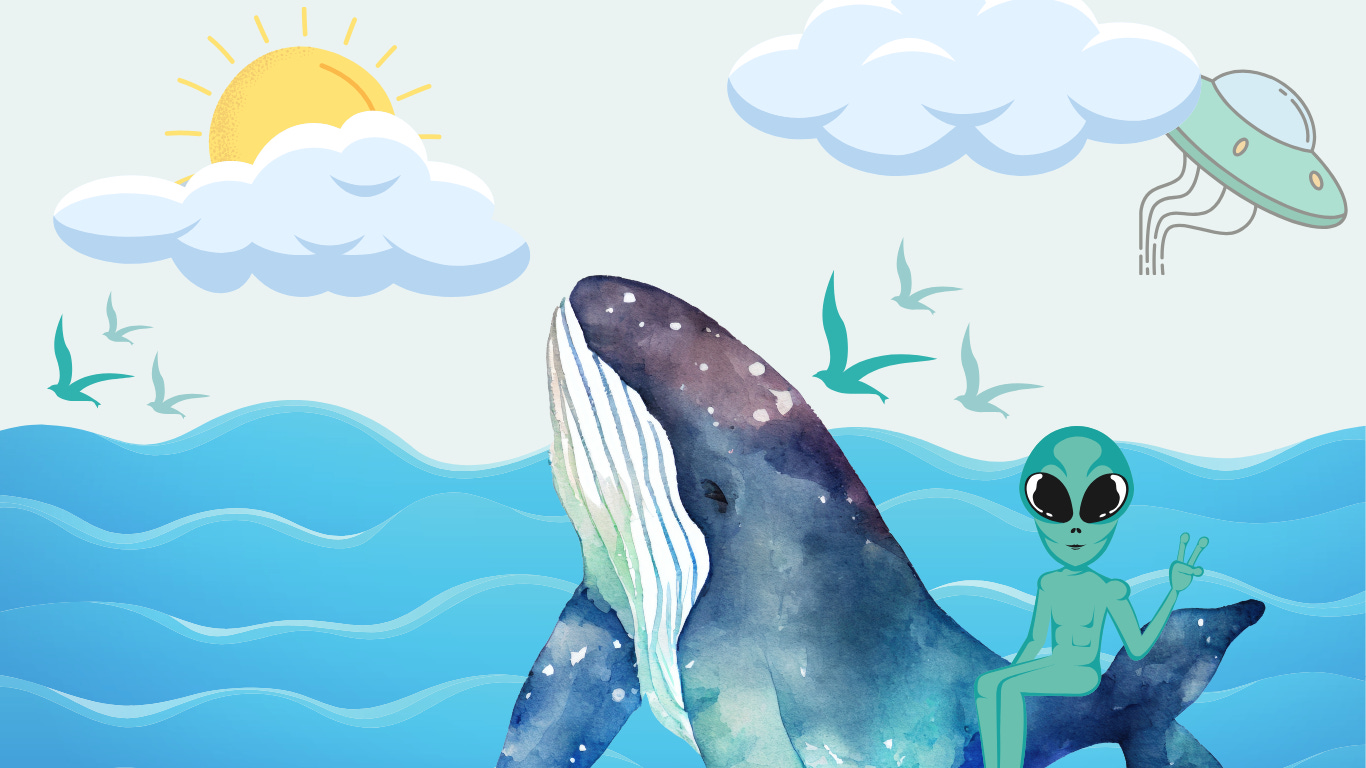



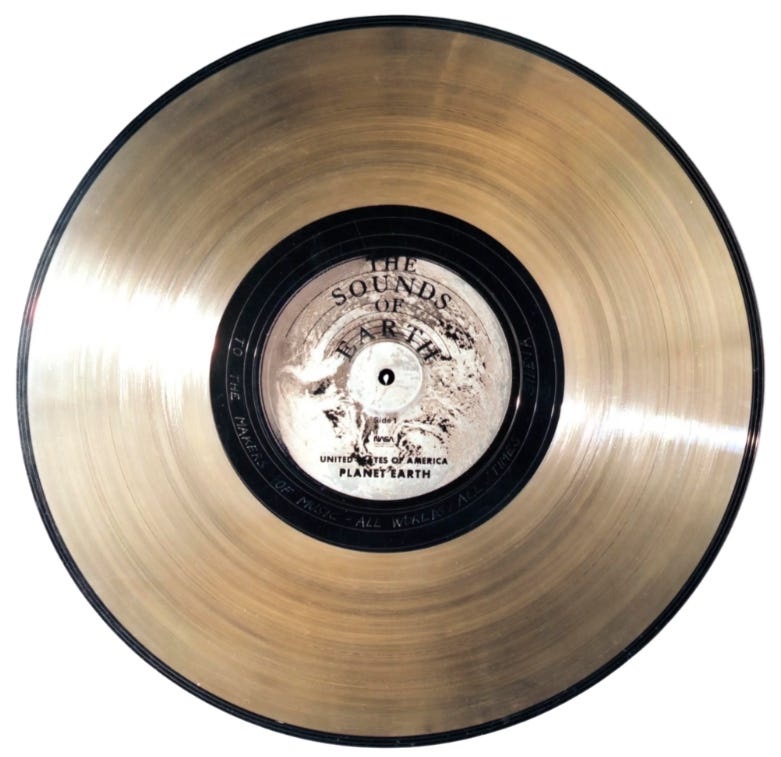

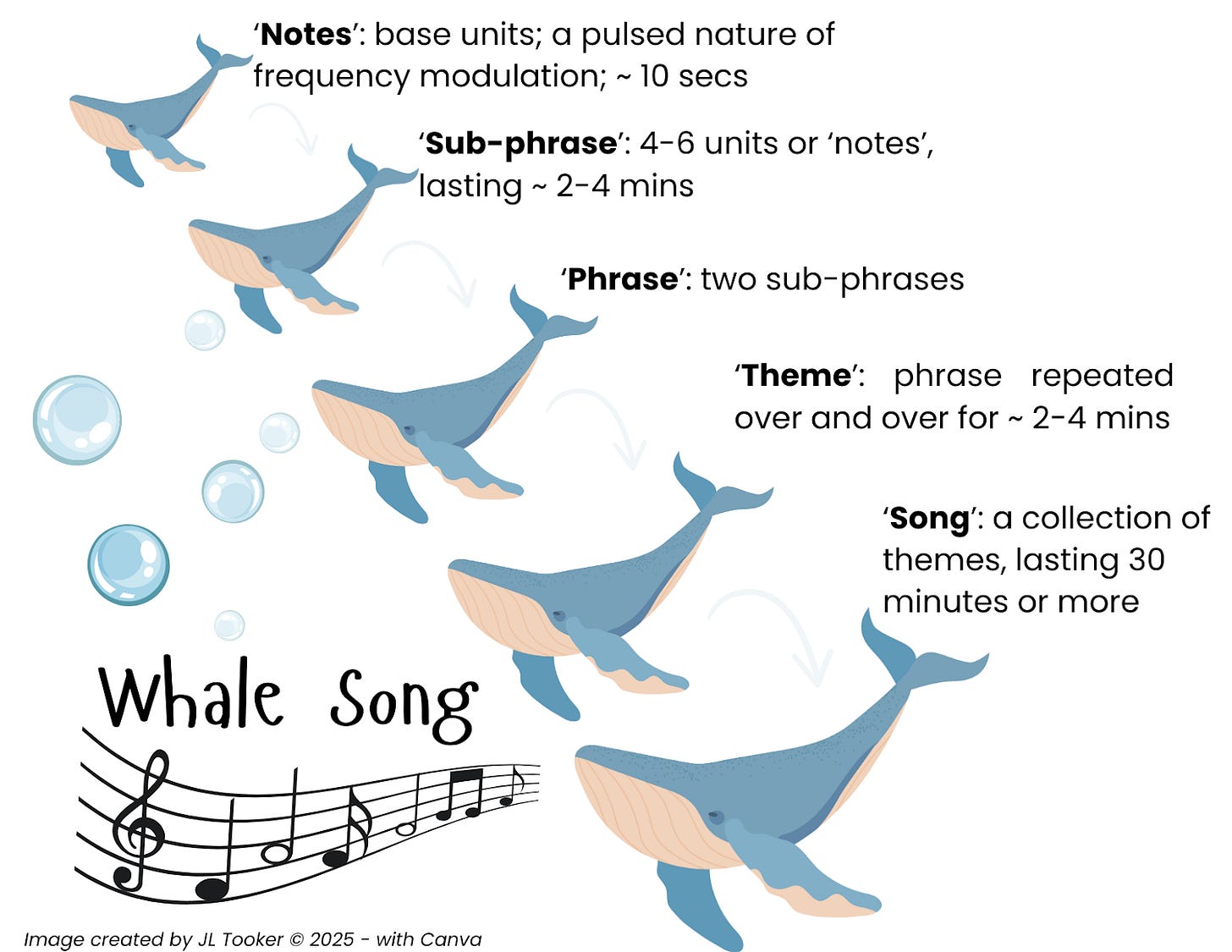
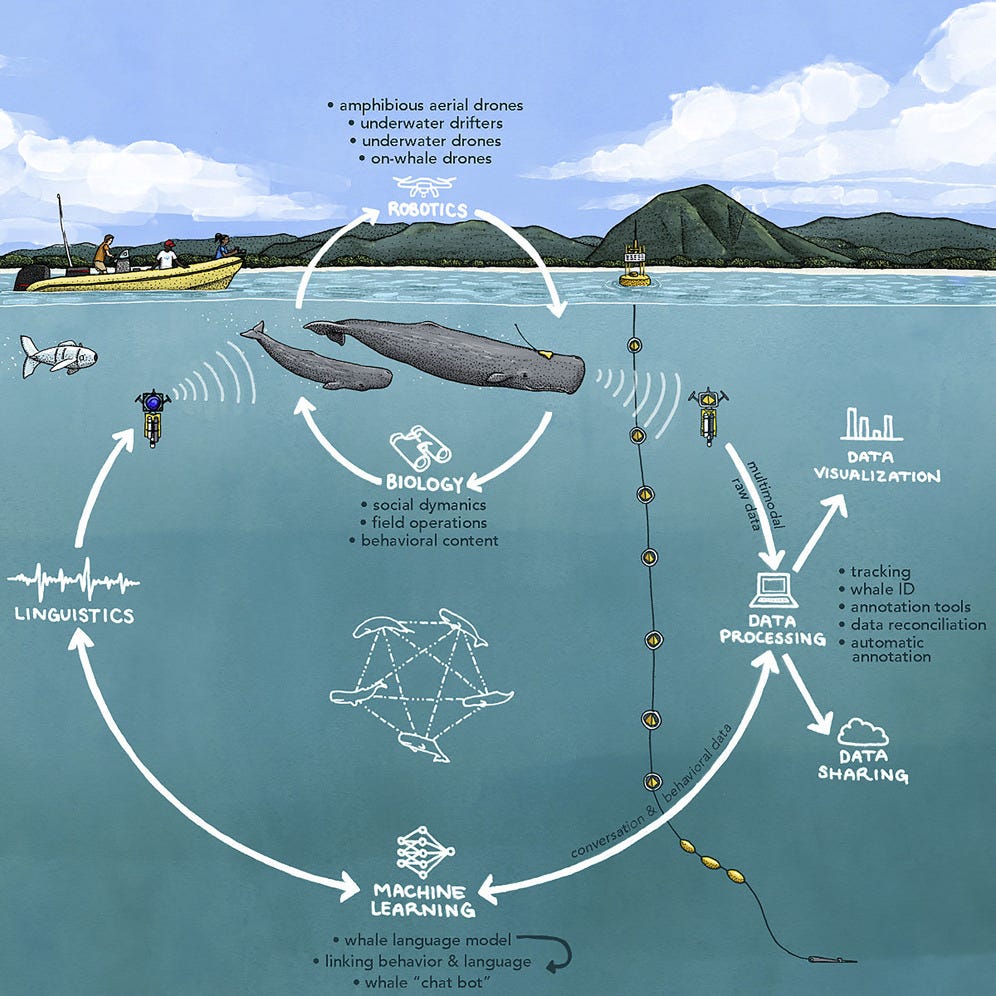




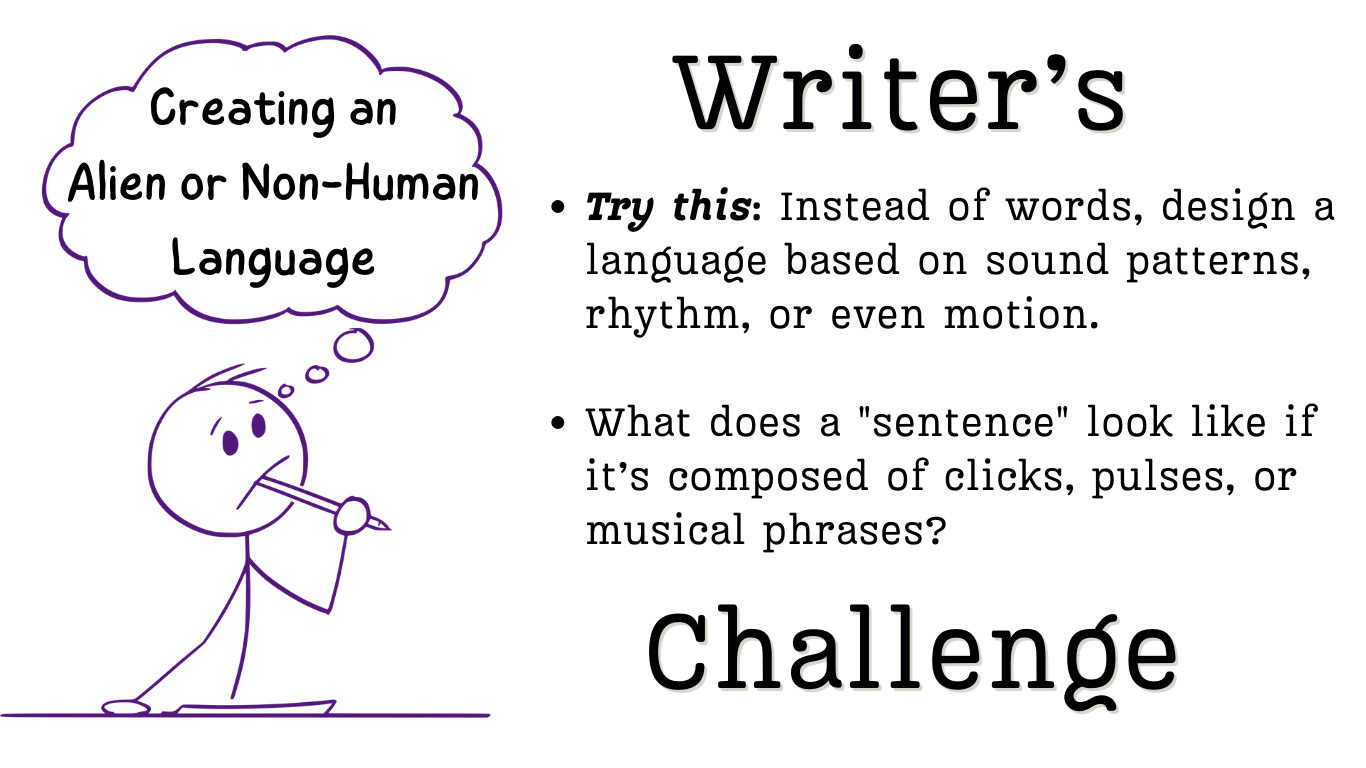


Picard and Dathon at El-Adrel
Have you heard of or read Blindsight? It's more about questioning self-consciousness and such but trying to figure out the alien language played a big part of that. Given where you are going, it seems worth checking out and at least reading a summary if you don't want to read the whole book.